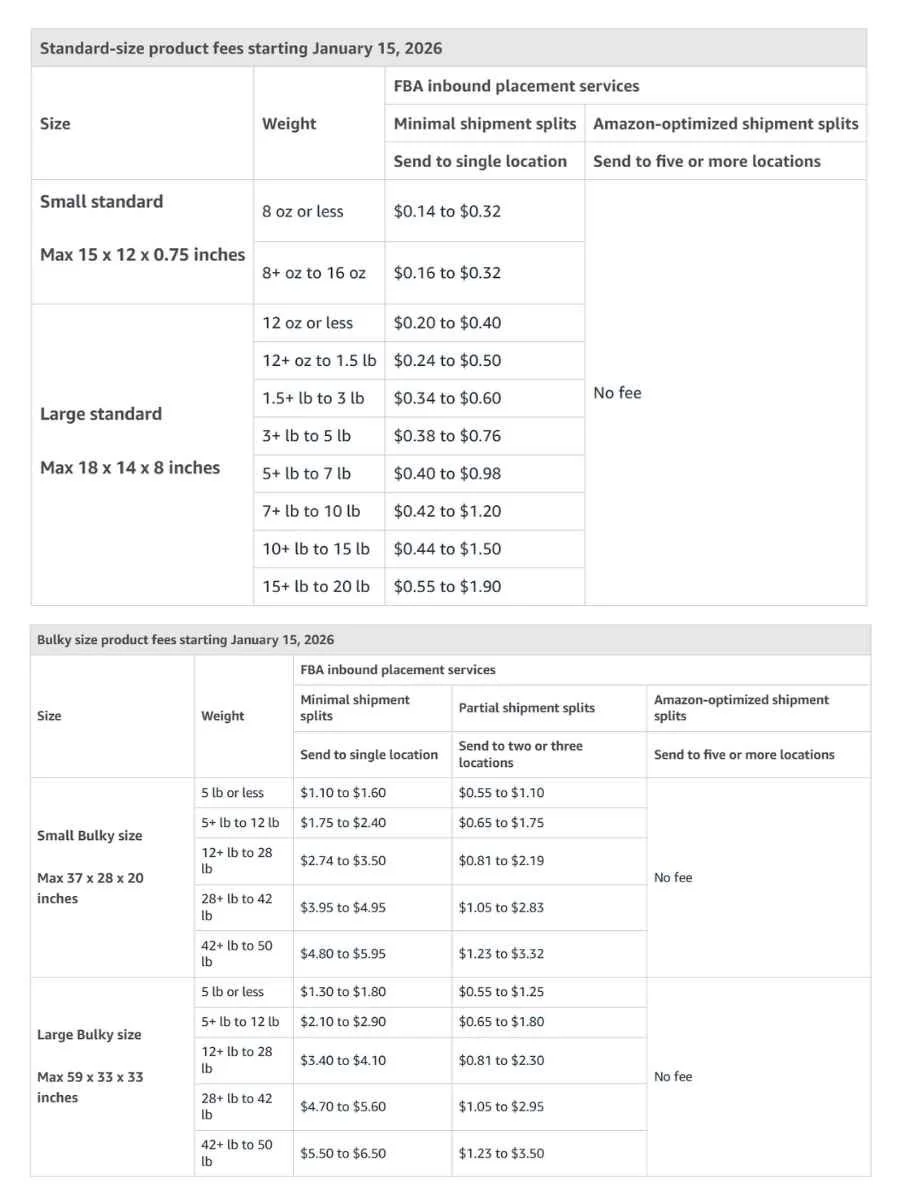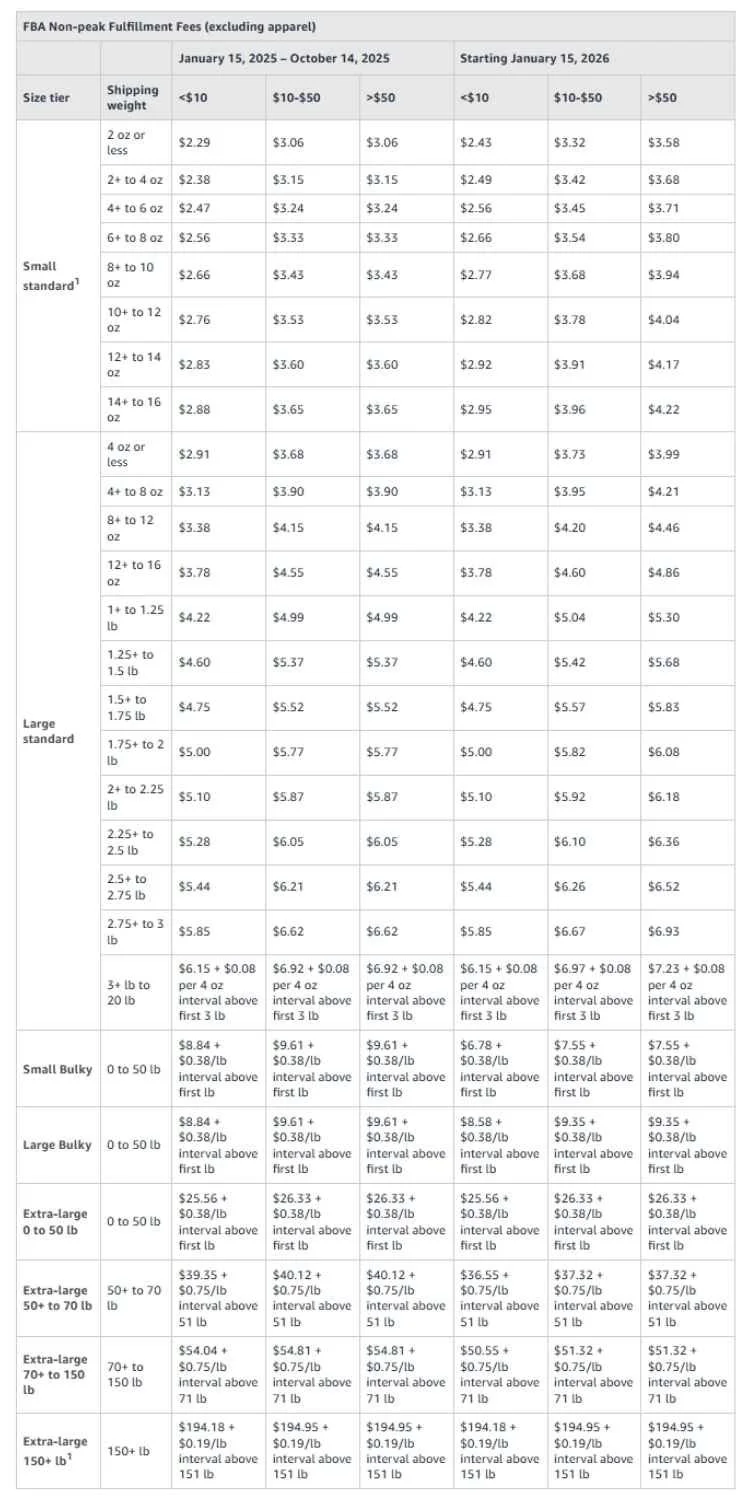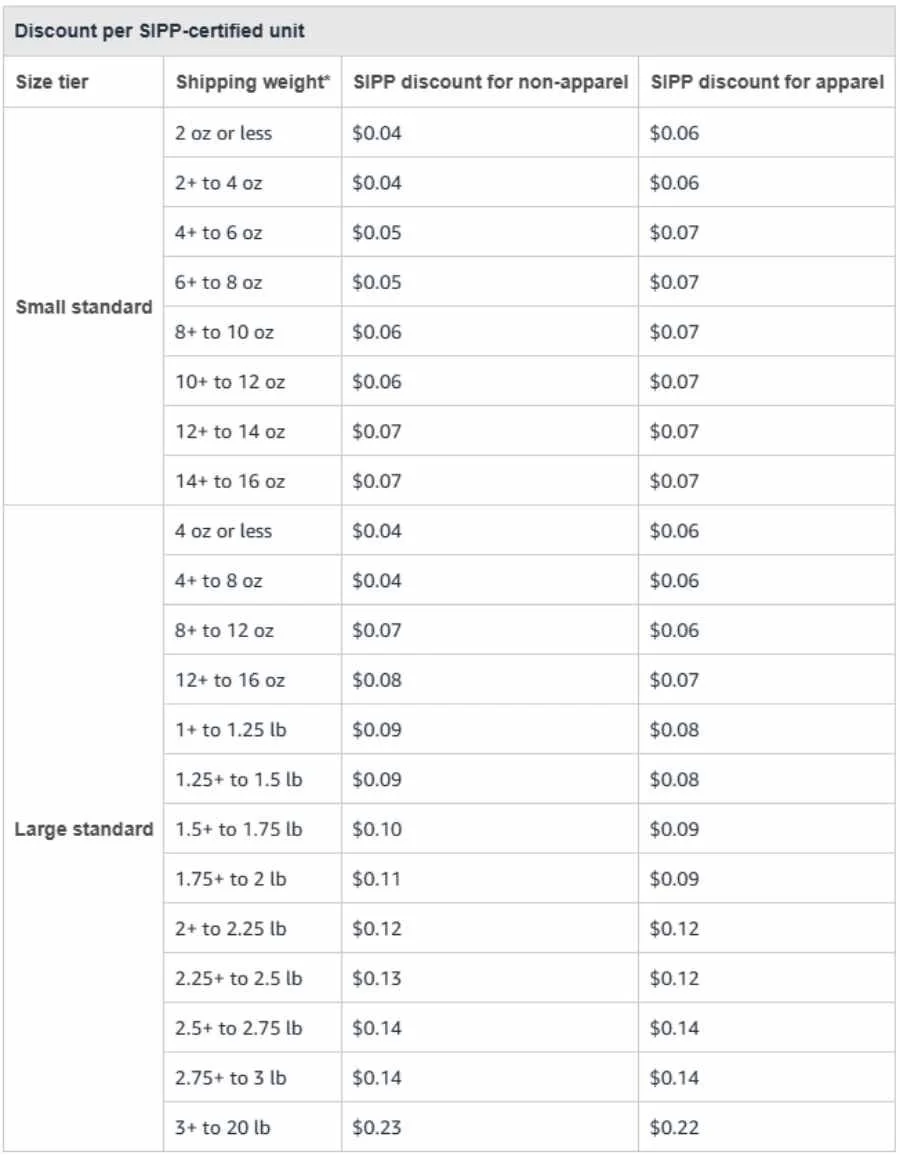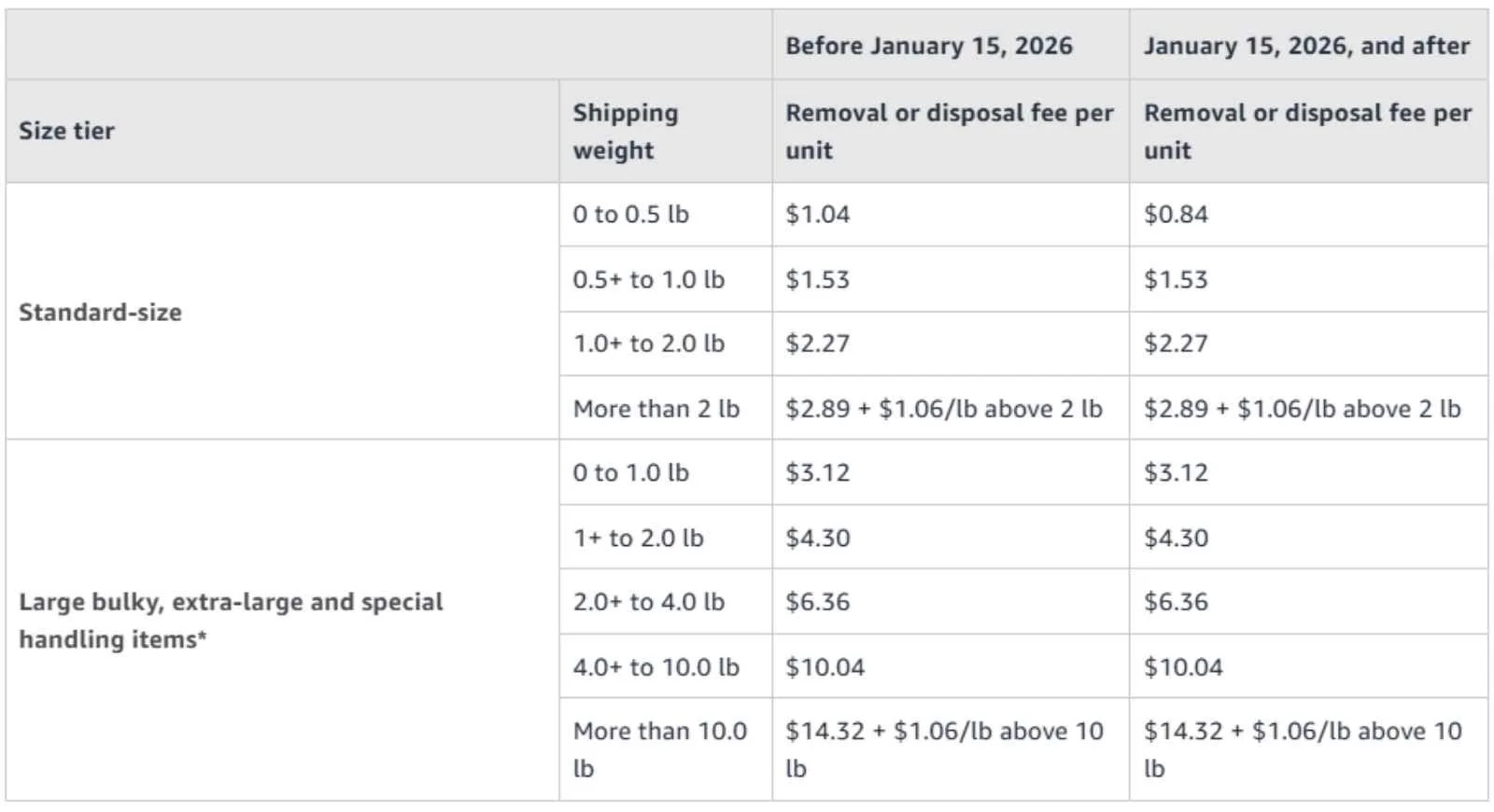Amazon recently announced the Amazon FBA fee changes for 2026. Understanding Fulfillment by Amazon’s current fees and costs is key to informing pricing and inventory management decisions. While Amazon is slightly raising the prices of Amazon FBA fees for 2026 it is important to remember the value of FBA. Amazon continues to be more granular in how fees are calculated, which makes it more fair for what you pay for the type of products you sell. In 2026, FBA fees will increase by an average of $0.08 per unit sold, or less than 0.5% of an average item’s selling price. This is also a significantly lower increase compared to other major US carrier cost increases. Outsourcing your inventory and fulfillment to Amazon, which is best in the world at storing and fulfillment, allows you to focus on what you do best.
This post will continue to show the granularity of fee structures in 2026 to help Amazon sellers have a better understanding of FBA costs. Understanding these metrics is important for meeting your sales, cost, and profitability goals in 2026.
Changes to Amazon FBA US Referral and Fulfillment by Amazon Fees for 2026
Amazon noted the US referral and fulfillment by Amazon fee changes for 2026 . Here are those key changes:
Standard-size products priced between $10-$50: Small standard-size product fulfillment fees in this price range will increase by $0.25 per unit, and Large standard-size product fees will increase by $0.05 per unit, on average.
Standard-size products priced below $10: Small standard-size product fulfillment fees in this price range will increase by $0.12 per unit on average. Large standard-size product fees will remain unchanged. Products priced below $10 will receive an increased fee discount of $0.86 per unit on average (up from $0.77 previously) compared to standard-size products priced $10 or higher.
Low-inventory-level fees will apply at the FNSKU level instead of parent-ASIN level. This change will help ensure we have sufficient inventory of the best-selling variations. Grocery products will now be exempt.
Standard-size products will see an inbound placement service fee increase of $0.05 per unit increase on average when using the minimal splits option. Additionally, Large standard-size products between 3-20 lb will be updated to include five new shipping weight bands.
Shipments that do not arrive, are late (abandoned), or are delivered to the wrong location will now be charged a single inbound defect fee of $0.60 per unit on average. Previously, these shipments would be charged both inbound placement service fees and inbound defect fees.
Minimum aged inventory fees for items 12-15 months old will increase by $0.15 per unit to $0.30 per unit per month. This fee will continue to be incurred based on whichever is greater, the updated fee of $0.30 per unit or $6.90 per cubic foot (which is unchanged).
Items aged over 15 months will incur monthly aged inventory fees of $0.35 per unit or $7.90 per cubic feet, whichever is greater. We will add this new aged inventory fee tier to better align with the costs of holding these items.
Removal and disposal fees for standard-size aged items weighing less than 0.5 lb will be reduced by $0.20 per unit. This change will encourage timely removal of excess inventory.
Fulfillment fees will on average decrease by $2.06 per unit for Small Bulky and by $0.26 per unit for Large Bulky products. The majority of Bulky products already using SIPP will see a net fee reduction.
Small and Large Bulky products that are not eligible for SIPP will incur a packaging fee averaging $2.07 per unit. This new fee reflects the costs incurred for providing these packaging services.
Low-inventory-level fees and inbound placement service fees will apply to Small and Large Bulky products. Large Bulky products using the minimal splits option will see an increase of $0.27 per unit on average and there will still be no fee for the Amazon optimized shipment splits option.
Extra-Large size product fees will decrease by $2.08 per unit on average. Most Extra-Large product tiers will see fee decreases. Products with irregular dimensions (Overmax size tier) will see fee increases to cover additional handling costs.
Changes to FBA Inventory Inbounding and Placement in 2026
The biggest changes in Inbounding and Placement fees will be that Amazon will will increase the inbound placement service fee for standard size product by an average of $0.05 per unit and introduce two shipping weight bands for small standard and five shipping weight bands for large standard size products between 3 to 20lbs. The Large Bulky size tier will also be split into Small and Large Bulky size tiers and increase the minimal shipment split fees for the new Large Bulky size tier by an average of $0.27 per unit. Here is a breakdown of the Inbound and Placement fees for 2026:
Sellers that use Amazon Warehousing & Distribution (AWD) from Supply Chain by Amazon will pay no inbounding fees, which adds increased value to the upstream inventory storage service.
Changes to Amazon FBA Fulfillment Fee 2026
There are a few changes to the Amazon Fulfillment Fees for 2026. Amazon continues to be more granular in the metrics used to calculate your FBA fulfillment fees. It is important to now consider price (on top of dimension and weight). By creating a more granular size tier, a seller that was previously on the low end of a particular size tier will benefit from this change. Here is the Size tier and fulfillment Fee card for 2026 for Amazon FBA Fulfillment Fees (excluding Apparel products):
Ships in Product Packaging (SIPP) Cost Saving Program 2026
Amazon is continuing the Ships in Product Packaging (SIPP) cost savings program opportunity, which appears to be a rebranding of Amazon’s SIOC (Ships in Own Container) program, which is a part of Amazon Frustration-Free Packaging initiative. SKUs enrolled in the program are eligible to receive a discount on FBA fees, depending on SKU size and weight. Focusing on packaging improvements will reduce costs by ensuring products have a minimal viable amount of packaging materials that still have the appropriate strength level to reduce damage in transit on top of the cost savings discount incentive provided by Amazon. Depending on the product, sellers are able to self-test products and record results to enroll in the SIPP program. Here is an overview of the rate card for potential discount savings:
Changes to Inventory and FBA Monthly Storage Fees 2026
At the time of this publication, Amazon will keep the same inventory and FBA monthly storage fee changes for 2026.
2026 FBA Monthly Storage Fees
The Monthly Storage Fee is a per cubic foot fee that is charged by Amazon FBA based on your usage of their warehouse storage space. During the holiday period (October - December) storage fees increase as demand for FBA storage increases alongside customer demand. Standard-size products and Large Bulky / Extra-large products are charged at different rates.
Low-Inventory-Level Fee 2026
The Low-Inventory-Level fee is charged when sellers fail to maintain on hand inventory to meet 28 historical days of supply. Amazon is adding this fee because when sellers carry low inventory relative to unit sales, it inhibits Amazon’s ability to distribute products across the FBA network, degrading delivery speed for Amazon customers and increasing shipping costs for Amazon. Here are the major updates for 2026:
To improve your ability to manage the fee, Amazon will calculate the historical days of supply metric at the seller-FNSKU level instead of the parent-ASIN level. This change ensures that only seller-FNSKUs with historical days of supply that are below 28 days will incur the fee.
Low-inventory-level fee will apply for Small Bulky and Large Bulky products going forward. Items under the Grocery category will be exempt.
Slower moving items will also remain exempt from low-inventory-level fees, but they may see slower delivery promises or limited nationwide availability.
See below for detailed fee rates.
Changes to Storage Utilization and Long Term Storage Fees 2026
This section will discuss the Monthly Inventory Storage fees and Long Term Storage Fee changes for 2026.
Storage Utilization Surcharge
Storage utilization surcharges will remain unchanged going into 2026. Amazon charges a storage utilization surcharge when sellers overstock inventory compared to recent demand and sell-through in Fulfillment Centers. This ensures that there is storage capacity for available inventory that is in high demand by customers, and it discourages sellers from overstocking inventory and wasting storage space. The surcharge is calculated by variables including Product Size Tier, Current Month, Product Volume, Average Daily Units Stored, Storage Utilization Ratio, and Dangerous Good Classification. Sellers can view their current storage utilization ratio in the FBA dashboard page of Seller Central.
New more granular storage utilization ratios will be added this year to align surcharges more closely to stocking behavior. Sellers who have irresponsibly overstocked quantities of their products with 44+ weeks plus utilization will be penalized with higher surcharges of $1.58 per cubic square foot for the ratio of 44 – 52 weeks and $1.88 per cubic foot 52+ weeks. Sellers can reduce these surcharges by closely monitoring inventory sell-through and maintaining stock levels below 22 weeks of utilization.
There are different Storage Utilization Surcharge fee structures used between off-peak periods (January-September) and peak periods (October-December). Depending on the seasonality of your business and customer demand, it is important to consider these costs based on the time of year you would like the inventory. Sellers that use Amazon Warehousing and Distribution are eligible for a storage utilization surcharge waiver.
Aged Inventory Long Term Storage Fee 2026
Long Term Storage Fee or Aged Inventory Surcharge fees will generally stay the same in 2026. Amazon charges inventory long term storage or aged inventory surcharges to discourage sellers from stocking high levels of inventory that does not have high sell-though. This helps keep storage capacity available for high-demand, high-sell products, which improves customer experience. Items aged between 181-270 days old will see the same Aged inventory surcharges. The only ages ranges that will see an increased surcharge in inventory 271 days or older. See below for surcharge changes to age ranges above 271 days. Sellers can reduce Long Term Storage Fees by pulling the Aged Inventory Surcharge report to get a better understand of current in-stock inventory age and by not stocking over 6 months of demand at a given time.
Changes to FBA Inventory Removal, Disposal, and Liquidation Fees 2024
FBA removal and disposal fees remain unchanged besides the Standard-size tier products weight 0 to 0.5lbs are reduced to from $1.04 to 0.84. Amazon FBA offers both inventory removal and disposal options for inventory that is not fit for distribution. The fee reflects Amazon’s costs related to picking the item out of storage and the cost of the removal shipment. Seller can minimize FBA removal and disposal cost by maintaining responsible FBA stock levels, paying close attention to item and box labeling, minimizing customer return rate and designing product packaging to reduce the rate of damage and breakage. See below for detailed information on rate changes:
FBA Liquidation fees will remain unchanged in 2026. FBA Liquidations allow sellers to have FBA inventory liquidated by Amazon through marketplaces and distribution outside of Amazon.com. In the liquidation Amazon FBA charges a Liquidation Fee per unit and a 15% liquidation referral fee then pays you a graded net recovery value for the unit. Graded net recovery value is typically 5%-10% of the products regular price.
Amazon Return Processing Fee
The Amazon Return processing fee will is charged to products that have return rates above a category specific threshold. The return rate will be calculated as follows (Product’s shipped units in a given month / Returns by customers over that month and the subsequent two calendar months = Product return rate). The categories of Apparel and Shoes will be exempt from this fee and will have a per order return processing fees charged. Depending on your category and return rate on your product, may provide cost saving to sellers. Where previously a “Return Processing Fee '' was charged for each product return, now a fee will only be charged if total return rate on the product surpasses the assigned category threshold. For sellers with low return rates on their products, this new structure should provide cost savings. This new threshold related charge puts increased emphasis on accurate merchandising of product detail pages to minimize customer return rate. Here is the 2026 Returns Processing Fee rate card
FAQ - Frequently Asked Questions on Amazon FBA Fee Changes for 2026
What is the Inbounding and Placement fee?
The Inbounding and Placement fee is the fee Amazon will be charging for Sellers sending inventory to a single Amazon FBA fulfillment center.
What is the Low-Inventory-Level fee?
The Low Inventory Level fee is the per square foot fee Amazon will be charging if Sellers fail to stock 28 days or more of unit sell through in FBA fulfillment centers.
How does Amazon calculate the FBA Storage utilization surcharge?
Amazon FBA calculates Storage utilization surcharges by considering Product Size Tier, Current month, Product Volume, Average Daily Units Stored, Storage Utilization Ratio (see [FBA Dashboard]), and Dangerous Good Classification status.
Are FBA Fulfillment Fees increasing in 2026?
In 2026, FBA fees will increase by an average of $0.08 per unit sold, or less than 0.5% of an average item’s selling price. This increase is significantly less than inflation and less than the 3.9%-5.9% annual cost increases from other major US carriers during the last two years.
What period of demand should be stocked in Amazon FBA Fulfillment centers to avoid both Low Inventory Level Fees and Storage Utilization Surcharges?
Low Inventory Level Fees are charged if less than 28 days of historic supply is stocked in Fulfillment Centers. Storage Utilization Surcharges start when the utilization ratio surpasses 26 Weeks or 6 Months of historical demand. In order to avoid incurring these fees sellers should maintain stock levels of between 1 month and 5 months of historic sell through.
How do I enroll in the Ships in Product Packaging (SIPP) program?
Enrollment will be available directly in Seller Central beginning on February 5th. Sellers can review SIPP’s requirements and enrollment process in preparation for enrollment.
Conclusion
Amazon’s FBA service remains one of the most comprehensive and flexible shipping and fulfillment solutions for Amazon sellers in the United States. Supply Chain by Amazon allows businesses to further utilize FBA’s value outside of strictly Amazon.com order fulfillment. New unique fees and increased existing fee rates will require increased focus to manage cost and in-stock availability responsibly. Between the new Low-Inventory-Level fees and increased range of Storage Utilization Surcharges, there is additional cost associated with understocking and overstocking products in FBA Fulfillment centers. New FBA Inventory Inbounding and Placement Fees may change what is best practice for inbounding inventory to fulfillment centers. Having a clear understanding of unit sell through and demand will be critical to achieving cost savings through these FBA changes. Goat Consulting helps our develop a clear understanding of FBA fulfillment cost and strategy. If you are interested in learning more your current or potential FBA costs, click the button below to start a conversation.
Disclaimer: The fee values were pulled at the time of writing and are subject to change. We cannot guarantee the accuracy of the values listed here and should be used for informational purposes only. Visit the Amazon help docs to ensure accurate Amazon Fee values and updates.







